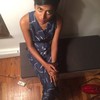Portrait by Elizabeth Renstrom
Advertisement
Advertisement
Advertisement
Resisting definition in the wake of a viral hit arguably enables fluidity in a circumscribed industry. Wise considers herself a rare hybrid among her web-savvy peers, who often can't or don't want to escape the ether, jaded about an offline art world ruled by "old white Swiss men," she said with a grin. Navigating both scenes is a challenge with "no precedent," she noted about the lack of art-world reference points. "There's nothing you can be like, Oh, that happened in the 80s. Nope, it did not actually."She finds role models all over the place. As we spoke, she gave the impression of a dutiful student of art history—referencing schools of art and names both obscure and obvious—and a passionate student of pop culture. In her constellation of influences, Karl Marx, who proposed the theory of the "commodity fetish," shares space with Drake, whose upbringing she both relates to and finds in comic contrast with his expected image as a rapper ("He's a Jewish Canadian nerd. My parents would love if I dated him!"). Most of all, though, she hailed Tim and Eric Awesome Show, Great Job!, the Adult Swim sketch series by Tim Heidecker and Eric Wareheim, whose deadpan approach to absurdism taught her that "confusion is key to the consumption of satirical or critical imagery." This insight is a thread through all of her hyper-real creations, from the bread bags to more recent work adorned with overdone symbols of bondage culture: for example, a urethane stack of pancakes ribbed with piercings, and a plate of fake bacon strips shaped like the Louis Vuitton logo, linked by chain to a leather wristband. The sculptures' verisimilitude confuses the senses, as does Wise's obvious obsession with them.I'm not a hater, I'm a hedonist. I love a lot of things. I eat so much, I love kisses, I love shopping, I love tanning. I'm a maximalist.
Advertisement
